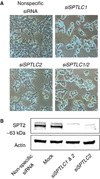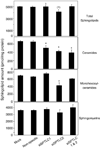Serine palmitoyltransferase subunit 1 is present in the endoplasmic reticulum, nucleus and focal adhesions, and functions in cell morphology
- PMID: 19362163
- PMCID: PMC2801055
- DOI: 10.1016/j.bbalip.2009.03.016
Serine palmitoyltransferase subunit 1 is present in the endoplasmic reticulum, nucleus and focal adhesions, and functions in cell morphology
Abstract
Serine palmitoyltransferase (SPT) has been localized to the endoplasmic reticulum (ER) by subcellular fractionation and enzymatic assays, and fluorescence microscopy of epitope-tagged SPT; however, our studies have suggested that SPT subunit 1 might be present also in focal adhesions and the nucleus. These additional locations have been confirmed by confocal microscopy using HEK293 and HeLa cells, and for focal adhesions by the demonstration that SPT1 co-immunoprecipitates with vinculin, a focal adhesion marker protein. The focal adhesion localization of SPT1 is associated with cell morphology, and possibly cell migration, because it is seen in most cells before they reach confluence but disappears when they become confluent, and is restored by a standard scratch-wound healing assay. Conversely, elimination of SPT1 using SPTLC1 siRNA causes cell rounding. Thus, in addition to its "traditional" localization in the ER for de novo sphingolipid biosynthesis, SPT1 is present in other cellular compartments, including focal adhesions where it is associated with cell morphology.
Figures










Similar articles
-
Novel functional association of serine palmitoyltransferase subunit 1-A peptide in sphingolipid metabolism with cytochrome P4501A1 transactivation and proliferative capacity of the human Glioma LN18 brain tumor cell line.Int J Environ Res Public Health. 2006 Sep;3(3):252-61. doi: 10.3390/ijerph2006030030. Int J Environ Res Public Health. 2006. PMID: 16968971 Free PMC article.
-
The ORMDL/Orm-serine palmitoyltransferase (SPT) complex is directly regulated by ceramide: Reconstitution of SPT regulation in isolated membranes.J Biol Chem. 2019 Mar 29;294(13):5146-5156. doi: 10.1074/jbc.RA118.007291. Epub 2019 Jan 30. J Biol Chem. 2019. PMID: 30700557 Free PMC article.
-
Serine palmitoyltransferase assembles at ER-mitochondria contact sites.Life Sci Alliance. 2021 Nov 16;5(2):e202101278. doi: 10.26508/lsa.202101278. Print 2022 Feb. Life Sci Alliance. 2021. PMID: 34785538 Free PMC article.
-
Serine Palmitoyltransferase Subunit 3 and Metabolic Diseases.Adv Exp Med Biol. 2022;1372:47-56. doi: 10.1007/978-981-19-0394-6_4. Adv Exp Med Biol. 2022. PMID: 35503173 Review.
-
Sphingolipid synthetic pathways are major regulators of lipid homeostasis.Adv Exp Med Biol. 2011;721:139-48. doi: 10.1007/978-1-4614-0650-1_9. Adv Exp Med Biol. 2011. PMID: 21910087 Review.
Cited by
-
A Rheostat of Ceramide and Sphingosine-1-Phosphate as a Determinant of Oxidative Stress-Mediated Kidney Injury.Int J Mol Sci. 2022 Apr 4;23(7):4010. doi: 10.3390/ijms23074010. Int J Mol Sci. 2022. PMID: 35409370 Free PMC article. Review.
-
Factors to consider in using [U-C]palmitate for analysis of sphingolipid biosynthesis by tandem mass spectrometry.J Lipid Res. 2011 Aug;52(8):1583-94. doi: 10.1194/jlr.D015586. Epub 2011 May 17. J Lipid Res. 2011. PMID: 21586681 Free PMC article.
-
Cell polarity factor Par3 binds SPTLC1 and modulates monocyte serine palmitoyltransferase activity and chemotaxis.J Biol Chem. 2009 Sep 11;284(37):24881-90. doi: 10.1074/jbc.M109.014365. Epub 2009 Jul 10. J Biol Chem. 2009. PMID: 19592499 Free PMC article.
-
Sphingolipid and glycosphingolipid metabolic pathways in the era of sphingolipidomics.Chem Rev. 2011 Oct 12;111(10):6387-422. doi: 10.1021/cr2002917. Epub 2011 Sep 26. Chem Rev. 2011. PMID: 21942574 Free PMC article. Review. No abstract available.
-
Sphingosine Kinase 2 Regulates Aryl Hydrocarbon Receptor Nuclear Translocation and Target Gene Activation.Adv Sci (Weinh). 2024 Oct;11(40):e2400794. doi: 10.1002/advs.202400794. Epub 2024 Aug 29. Adv Sci (Weinh). 2024. PMID: 39207053 Free PMC article.
References
-
- Alvarez SE, Milstien S, Spiegel S. Autocrine and paracrine roles of sphingosine-1-phosphate. Trends Endocrinol. Metab. 2007;18:300–307. - PubMed
-
- Hannun YA, Obeid LM. Principles of bioactive lipid signalling: lessons from sphingolipids. Nat. Rev. 2008;9:139–150. - PubMed
-
- Merrill AH, Jr, Wang MD, Park M, Sullards MC. (Glyco)sphingolipidology: an amazing challenge and opportunity for systems biology. Trends Biochem. Sci. 2007;32:457–468. - PubMed
-
- Spiegel S, Milstien S. Sphingosine-1-phosphate: an enigmatic signalling lipid. Nat. Rev. 2003;4:397–407. - PubMed
Publication types
MeSH terms
Substances
Grants and funding
LinkOut - more resources
Full Text Sources
Medical

